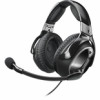Sennheiser S1 DIGITAL Instructions for use - Page 3
Important safety information, S1 DIGITAL - aviation headset
 |
View all Sennheiser S1 DIGITAL manuals
Add to My Manuals
Save this manual to your list of manuals |
Page 3 highlights
Important safety information Important safety information ̈ Please read this instruction manual carefully and completely before using the product. ̈ Always include this instruction manual when passing the product on to third parties. ̈ This instruction manual is also available on the Internet at www.sennheiser-aviation.com or www.sennheiser.com. Preventing health problems and accidents ̈ Always maintain a distance of at least 3.94" (10 cm) between the ear cups and the cardiac pacemaker or implanted defibrillator since the product generates permanent magnetic fields. ̈ Keep product, accessory and packaging parts out of reach of children who could swallow smaller pieces. ̈ Switch the product off after use to conserve battery power. Remove the rechargeable batteries if the product will not be used for extended periods of time. ̈ If during flight operation you, as the pilot, operate your connected Bluetooth® device using the headset, this can limit your attention. During flight operation, do not use the headset for making phone calls or listening to music. ̈ With the NoiseGardTM/digital noise compensation switched on, typical aircraft sounds (for example, those from engines, propellers, warning alarms, etc.) may sound different to you. Before operating any aircraft, make sure that, with NoiseGardTM/digital switched on, you can hear and recognize these sounds. Set the volume to safe levels that do not interfere with your ability to hear informational sounds and warning alarms. ̈ The product is capable of producing sound pressure exceeding 85 dB(A). In many countries 85 dB(A) is the maximum legally permissible level for continuous noise exposure during the working day. Do not listen at high volume levels for long periods of time to prevent hearing damage. Preventing damage to the product and dysfunctions ̈ Always keep the product dry and do not expose it to extreme temperatures (hairdryer, heater, extended exposure to sunlight, etc.) to avoid corrosion or deformation. ̈ Only use the product in environments where wireless Bluetooth transmission is permitted. ̈ Only clean the product with a soft, dry cloth. ̈ Never repair or attempt to repair a defective product yourself. Contact your Sennheiser partner or the Sennheiser Service Department. 2 | S1 DIGITAL












